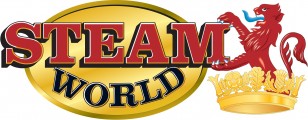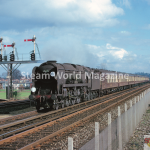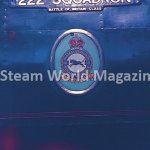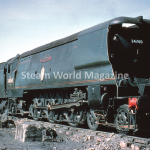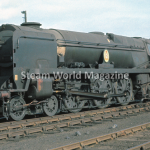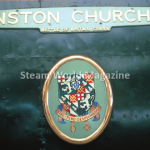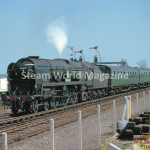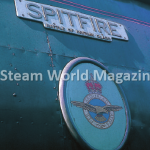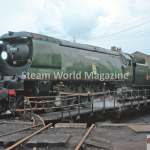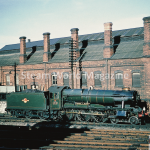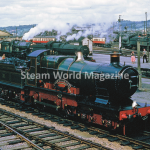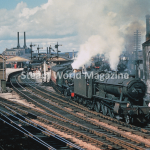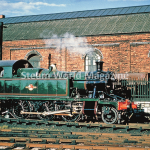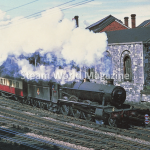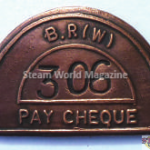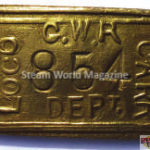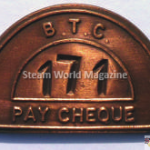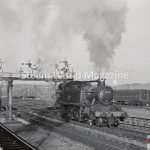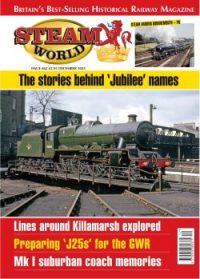- Rebuilt LYR class 2P 2-4-2T No.50686 Outside Horwich Works on August 17 1955
- LYR narrow gauge 0-4-0ST Wren seen during a works visit to Horwich in August 1953. e.v. Fry/rail archive STephenSon
- Gleaming ex-works Hughes/Fowler ‘Crab’ 2-6-0 No. 42820, built at Horwich in 1929, stands outside the works on September 30 1961. chriS ForeST/rail archive STephenSon
- Double-chimney Stanier ‘Jubilee’ class 4-6-0 No. 45596 Bahamas at Horwich Works with its tender tank on a well wagon on October 13 1963. The preserved locomotive is soon to undergo an extensive restoration to working order. T.G. hepburn/rail archive STephenSon
- In patchwork primer, Stanier Class ‘3P’ 2-6-2T No. 40196 awaits entry to the paint shop at Horwich October 7 1951 after a general repair on. D.T. GreenwooD/rail archive STephenSon
- Rebuilt ‘Battle of Britain’ 4-6-2 No. 34071 601 Squadron approaches Esher station, from Hampton Court Junction, with the down ‘Bournemouth Belle’ Pullman express in March 1966. Geoff Rixon
- Under BR some nameplates received black and others red backgrounds. Later ‘sky blue’ was adopted for the ‘Battle of Britain’ class but not all locomotives received it. On May 1 1954 No. 34078 222 Squadron carries a black-backed nameplates at Eastleigh works. ColouR-Rail
- One of the ‘Battle of Britain’ 4-6-2s to be allocated to West Country depots, No. 34060 25 Squadron of Exmouth Junction (72A) stands on shed carrying a red-backed nameplate and the black-painted lower cab sidesheets, while coupled to a cut-down tender carrying the later style BR crest. Jim oatway
- A very grimy rebuilt ‘BoB’ No. 34082 615 Squadron stands at its home shed, Eastleigh (70D) in April 1964. Under the dirt, the nameplate appears to be red-backed, quite unusual on a rebuilt ‘Battle of Britain’. Geoff Rixon
- The nameplate of No. 34051 Winston Churchill. The wing shape of the plate varied according to the length of the name, so longer names like this looked more wing-like. Unusually, the motto of the Duke of Marlborough was in Spanish rather than Latin. Geoff Rixon
- Rebuilt ‘Battle of Britain’ 4-6-2 No. 34056 Croydon passes Esher with a typical Basingstoke semi-fast in June 1966. Nameplates and badges were re-arranged to suit rebuilt locomotives. Geoff Rixon
- The very short nameplate of No. 34066 Spitfire. The badge and motto are those of the Royal Air Force. This locomotive was sometimes considered jinxed, having been involved in several incidents including the major accident at Lewisham on December 4 1957 in which 90 people died. Geoff Rixon
- ‘Battle of Britain’ 4-6-2 No. 34064 Fighter Command was the unique example fitted experimentally with a Giesl exhaust. It was photographed on the turntable at Nine Elms in February 1965 shortly after doing duty, at Staines, as the standby locomotive for Sir Winston Churchill’s funeral train. Geoff Rixon
- Smart ‘County’ 4-6-0 No. 1016 County of Hants waits to come off shed at Newton Abbot in August 1959. Locomotive changes, piloting over the banks, and supplying locomotives for up services from Torquay were among the main jobs at Newton Abbot. Peter Gray/Colour-rail
- Returned to steam in 1957, celebrity 4-4-0 No. 3440 City of Truro toured the west country with a Westerward TV exhibition train highlighting the launch of the new commercial TV channel. on 19 may 1957 No. 3440 was at Newton Abbot. Peter Gray/Colour-rail
- Double-heading a ‘Castle’ 4-6-0, ‘County’ 4-6-0 No. 1010 County of Caernarvon departs Newton Abbot with a down express in summer 1958. Another down train waits at the adjacent platform, and the shed yard in the right background, is busy. B.J. Swain/Colour-rail
- Since preserved, ‘45XX’ 2-6-2T No. 4566, the last locomotive to go through Newton Abbot works, has received some special treatment and gleams in the evening sun in July 1960. Peter Gray/Colour-rail
- An early BR colour view at Newton abbot in 1951, shortly before the author started work there, as ‘hall’ 4-6-0 No. 4966 Shakenhurst Hall departs Newton Abbot with a down local which, in typical gWR fashion, carries express lamps. eriC olDHaM/Colour-rail
- A broad view of Newton Abbot showing one of its signal gantries, which were to become a well-known landmark in later years. ‘5101’ class 2-6-2T No. 5158 dominates the scene. l.F. FolKarD/Colour-rail




